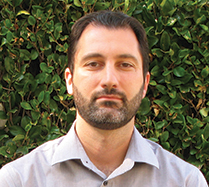
Dr. Hagop Atamian
- Education:
- American University of Beirut, Bachelor of Science
American University of Beirut, Master of Science
University of California, Riverside, Ph.D.
Biography
Education
2013-18
Postdoctoral Fellow, Dept. of Plant Biology, UC Davis (Mentor: Prof. Stacey L Harmer)
2007-12
Ph.D. in Molecular Genetics, Dept. of Nematology, UC Riverside
2004-06
M.S. in Plant Protection, Faculty of Agriculture and Food Science, American University
of Beirut (Mentor: Prof. Yusuf Abou Jawdah)
Research Interests
Dr. Atamian’s research interests broadly aim at understanding the molecular mechanisms of plant interactions with the environment. These include biotic interactions (insects, bacteria, fungi, nematodes) and various biotic stresses (drought, cold, heat) as well as daily environmental fluctuations. He uses high throughput sequencing and molecular approaches together with physiological field experiments to better understand plant genotype x environment interactions.
Keywords
Biotic, abiotic, plant, genotype, transcriptome, genome, circadian clock, microbiome, hormone, light, temperature, pest, pathogen
Selected Publications
Click here for complete list of publications
Chaudhary R, Atamian HS (2017) Resistance-gene-mediated defense responses against biotic stresses in the crop model plant tomato. Journal of Plant Pathology and Microbiology 8:404.
Atamian HS, Creux NM, Brown EA, Garner AG, Blackman BK and Harmer SL (2016) Circadian regulation of sunflower heliotropism, floral orientation, and pollinator visits. Science 353: 587-590.
The article was featured on the cover of the August 2016 issue.
Atamian HS and Harmer SL (2016) Circadian regulation of hormone signaling and plant physiology. Plant Molecular Biology 91: 691–702.
Ouyang S, Park G, Atamian HS, Han CS, Stajich JE, Kaloshian I and Borkovich KA (2014) MicroRNAs suppress NB domain genes in tomato that confer resistance to Fusarium oxysporum. PLoS Pathogens 10: e1004464.
Chaudhary R, Atamian HS, Shen Z, Briggs SP and Kaloshian I (2014) GroEL from the endosymbiont Buchnera aphidicola betrays the aphid by triggering plant defense. Proceedings of the National Academy of Sciences USA 111: 8919–8924.
Atamian HS, Chaudhary R, Dal Cin V, Girke T and Kaloshian I (2013) In planta expression or delivery of potato aphid Macrosiphum euphorbiae effectors Me10 and Me23 enhances aphid fecundity. Molecular Plant-Microbe Interactions 26: 67-74.
Atamian HS, Eulgem T and Kaloshian I (2012) SlWRKY70 is required for Mi-1-mediated resistance to aphids and nematodes in tomato. Planta 235: 299-309.
Bhattarai KK, Atamian HS, Kaloshian I and Eulgem T (2010) WRKY72-type transcription factors contribute to basal immunity in tomato and Arabidopsis as well as gene-for-gene resistance mediated by the tomato R gene Mi-1. The Plant Journal 63: 229–240.
Gerardo NM, Altincicek B, Anselme C, Atamian HS, Barribeau SM, de Vos M, Duncan E, Evans JD, Gabaldon T, Ghanim M, Heddi A, Kaloshian I, Latorre A, Moya A et al. (2010) Immunity and other defenses in pea aphids, Acyrthosiphon pisum. Genome Biology 11: R21.
-
Recent Creative, Scholarly Work and Publications